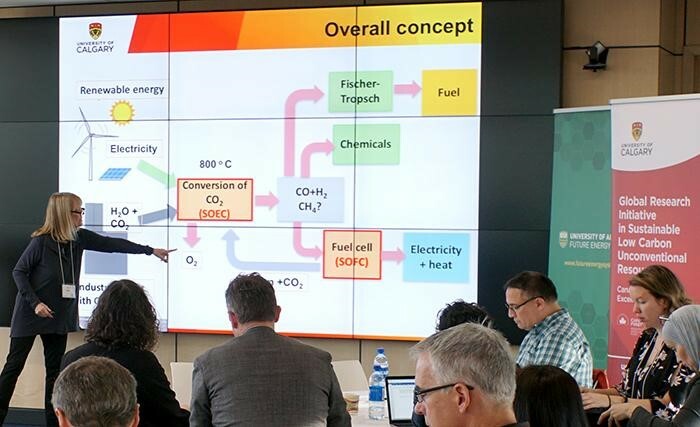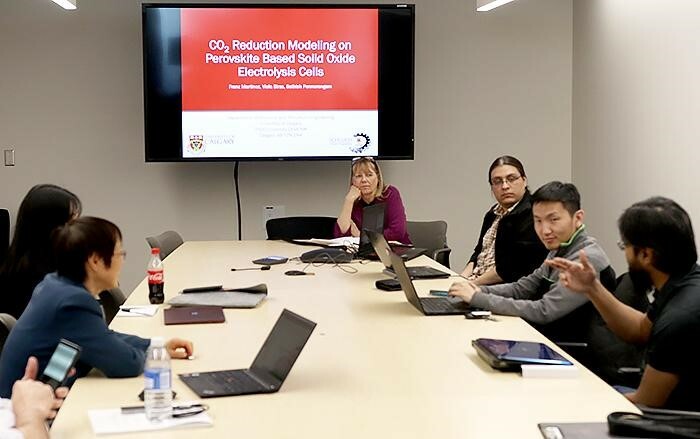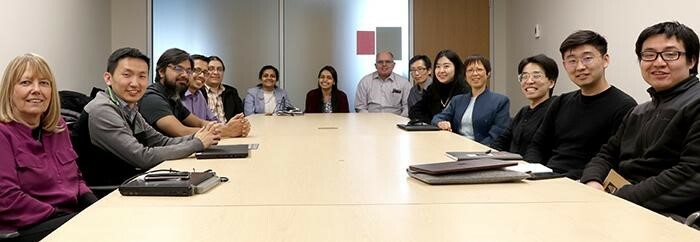Together for the challenge
Posted on
Viola Birss and Jingli Luo had been collaborating for years when the UAlberta-UCalgary CFREF partnership gave them the chance to go big on carbon capture and utilization
It’s Friday afternoon, and after a morning of round-table discussions at the Future Energy Systems - Global Research Initiative joint workshop, professors, post-docs, and graduate students from both programs are filing into a conference room at the University of Alberta. Even though not everyone at work on their collaboration is attending, they still number more than twenty –– a collection of leading researchers representing nine different research groups who are developing new technologies to target CO2 emissions.
Viola Birss, Professor of Chemistry at the University of Calgary, brings the meeting to order. “I thought we’d start with a brief overview of the project, to fill everyone in on the history of it, between Jingli and me.” She motions to the University of Alberta’s Jingli Luo, a Professor of Materials Engineering, and the technical meeting begins. They have a lot of ground to cover.
As technological research rapidly advances and evolves, researchers and visionaries often rush to be the first to achieve success and proclaim personal victories in their fields. Sometimes, this individual focus leads to closed labs and closed lips –– an “us vs. them” competitiveness between research groups that impedes as much as it motivates. Birss and Luo have long pursued a different path: working together.
“We can do much better by sharing our work than by hiding it,” Birss says.
For more than a decade these two women have been defying research protectionism and institutional rivalries as they tackle the crisis of greenhouse gas emissions. Their potential solution: solid oxide electrolyzer cells (SOECs), a promising, scalable green technology that can transform carbon dioxide into fuels such as diesel and natural gas.
It all began with a joint venture through the Alberta Fuel Cell Initiative (AFCI) and persevered through the ups and downs that followed, from the Western Canadian Fuel Cell Initiative to the Solid Oxides Fuel Cells Canada network, to the Alberta Innovates Technology Futures research that began their current venture. For years they have built the foundations for this technology, and when the Canada First Research Excellence Fund granted both their institutions funds for energy research, they grew the collaboration to a new scale.
“Our partnership has always been valuable,” Jingli says. “The new funding allows us to include more people and speed our progress.”
Fuel from CO2

The basic aim of an SOEC is to make use of captured carbon dioxide. This is accomplished through a reaction between the CO2 water on the surface of a special, electrically charged material called an electrocatalyst, with the result being carbon monoxide and hydrogen gas (syngas). The syngas can then be further transformed into fuels, or even fed into a solid oxide fuel cell (SOFC), producing energy. The combination of these two steps means this technology can effectively act as either a battery or a storage solution for renewable energy.
“The system can work in two directions which makes it a very interesting solution for carbon emissions,” Birss explains. “The key is developing the right catalyst.”
Many chemical reactions are possible when enough energy is applied, but in order to maximize the value of this technology when paired with renewable sources, efficient catalysts are essential. This means the right sort of material must be identified and its activity measured. It also means that the structure of the catalyst’s molecule plays a role.
As the technical meeting continues, members of the Birss-Luo team address different aspects of their potential catalysts –– compounds with a specific crystalline structure, called perovskites. There’s a great deal of tunability in their synthesis and final form, and therefore a high degree of complexity that needs to be considered.
At the University of Calgary, researchers are seeking increased efficiency by refining specific chemical components of the perovskite catalysts. Meanwhile, the University of Alberta teams are working on the nanoparticle distribution of a perovskite variant. At first glance, it might appear that the two approaches are competing. In reality, the fact that they’re all together in one room long before their work is ready for academic publication is maximizing their chances of success.
Building clusters

Bringing any new technology to market can be a steep hill to climb. Research has to focus on both the theory behind the system and encompass every aspect of optimization, pushing the performance and efficiency ever higher. Beyond the lab, scaling up can present other challenges –– ensuring the economics are on your side, and potentially establishing a new start-up from scratch.
“If you follow the traditional route, having groups at different institutions not talk to each other but instead just publish competing findings, it’ll take years –– and key information about things that didn’t work might never be shared,” Birss comments after the meeting.
“The importance of quickly finding solutions for cleaner energy makes collaborating even more important,” Jingli adds. “We think it is the best way to drive innovation.”
Thanks to the resources of Future Energy Systems and the Global Research Initiative, they’ve been able to build a broader team that shares their perspective, with group members sorted into clusters.
First is the theoretical cluster charged with understanding how and why certain perovskites function as good catalysts, helping determine which molecules might work best in the SOECs. This is led by Charlie Jin at the U of A and Sathish Ponnurangam at the U of C.
Next is the experimental cluster, which synthesizes and tests the catalysts under a variety of real world conditions and configurations. They can build from what the theoretical cluster proposes, and can in turn provide critical information for the theoretical cluster to incorporate. This cluster relies on the work of Jingli Luo, Manisha Gupta, and Ken Cadien at the U of A, and Viola Birss, Venkataraman Thangadurai and Simon Trudel at the U of C.
A newer addition is the economics cluster, which uses life-cycle analysis to demonstrate the business case for the technology and helps identify priorities for further refinement. Joule Bergerson at the U of C leads this cluster.
Finally, the scale-up cluster conducts market-minded electrochemical testing with the aim of moving the system towards commercial production. SeeO2 Energy, an offshoot startup emerging from Birss’ lab, is working closely with the project, learning from the researchers and also feeding back real-world data from the marketplace. Last year, the recent graduates helming SeeO2 were awarded GreenSTEM Fellowships by the Government of Alberta’s Department of Economic Development, Trade and Tourism –– an investment that gives them two years of startup funding to help get the SOEC platform into the marketplace.
Together, these clusters are making it possible for SOECs to go from the drawing board to the marketplace, though plenty of work lies ahead.
Not the same old way

Backed by two universities that both possess a robust energy research capacity, Birss and Luo have united a team that would be the envy of many research programs across Canada, and around the world. Now they’re shouldering the challenge together –– and making progress.
“Our partnership gives us the expertise we need to refine this technology and our students are building the conduit to get it to market,” Birss asserts. “It’s a clear sign that you can make a difference when you don’t just do things the same old way.”
“Our cooperation will continue for many years,” Jingli concludes. “We will develop products and train highly qualified personnel who understand the importance of collaboration.”
Ten years of communication have clearly confirmed for these two women the importance of sharing research and resources, and that understanding will shape all the innovation to come. As the technical meeting wraps up –– six hours after it began –– there is a sense of collegial appreciation and accomplishment among the participants, despite the intense, complex discussion. Another meeting in the books, with many more to come, as this team continues to pursue technologies that offer a greener future.
To learn more about the Advanced Electrochemical System for Energy Storage Through CO2 Conversion joint project, click here.